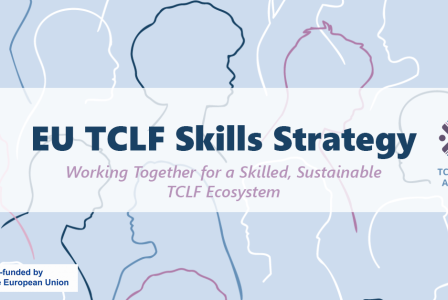Articles
09 October 2025
The EU TCLF Skills Strategy: a practical roadmap for a greener, more digital and more inclusive industry
Articles
09 October 2025
Infrastructure
Investments and funding
R&I, techniques and technological solutions
+16 more
Login / create an account to be able to react
-
14

Europe’s textile, clothing, leather and footwear ecosystem is entering a decisive decade. Nearly 1.5 million people work across about 220,000 mostly small and medium-sized companies that power both creative industries and vital supply chains for automotive, health and construction. The EU TCLF Skills Strategy translates this scale and diversity into a clear plan to equip people and firms with the capabilities they need for competitiveness, sustainability and quality jobs.
EURATEX
Aequalis4TCLF
COTANCE
EURATEX
European Confederation of the Footwear Industry
Topics
Albania
Armenia
Austria
Belgium
Bosnia and Herzegovina
Bulgaria
Croatia
Cyprus
Czechia
Denmark
Estonia
EU-27
Finland
France
Georgia
Germany
Greece
Hungary
Iceland
Ireland
Italy
Kosovo
Latvia
Liechtenstein
Lithuania
Luxembourg
Malta
Moldova
Montenegro
Netherlands
North Macedonia
Norway
Poland
Portugal
Romania
Serbia
Slovakia
Slovenia
Spain
Sweden
Switzerland
Türkiye
Ukraine
Other
Academic / Research and VET Institutions
Business Support Organisation
Company with 250 or more employees
Cluster Organisations
Consumer Organisations
Cultural and Heritage Organisations
Destination Management & Marketing Organisations
EU Institutions
Financial Institutions and Investors
Industry Associations and Chambers of Commerce
International Organisations
Local Authorities
Media / Journalist Organisations
National authorities
Networks and Federations / Confederations
NGOs / Non-profits
Notified Bodies
Regional Authorities
SMEs (a company with less than 250 employees)
Social Economy Entity
Trade Unions
Other
-
Transition Pathway's building blocks
-
-
Infrastructure
-
Investments and funding
-
R&I, techniques and technological solutions
-
Skills
-
Social dimension
-
Sustainable competitiveness
-
Regulation and public governance
-
-
Industrial ecosystems
-
-
Textile
-
-
Textiles ecosystem areas
-
-
Fibres, yarns and fabrics
-
Apparel and clothing accessories
-
Household/interior textiles
-
Technical textiles
-
Leather and fur
-
Footwear
-
Research and Innovation
-
Technology and Machinery
-
Waste management, reuse and repair
-
Business support and Communication
-
Not area specific (interested in more than one of the above)
-
Share
What is changing, and why skills matter
Production is evolving fast as artificial intelligence, automation, three-dimensional design and data-driven value chains reshape how products are conceived and made. At the same time, circular economy models and new regulatory expectations, from eco-design to traceability and repair, demand environmental literacy alongside technical excellence. The strategy confirms that the most urgent gaps lie in digital transformation skills such as CAD, CAM, 3D modelling and data management, and in green competences such as life-cycle assessment, sustainable materials and circular business models.
This is not only about technology. Persistent barriers include an ageing workforce, uneven access to modern training in some regions, difficulty for SMEs to invest in upskilling on their own, and a sector image that does not always reflect current innovation and career prospects. The strategy addresses these structural issues head-on.
A framework that turns ambition into action
The strategy is built around three connected pillars that together create a practical route to results. First comes developing relevant skills through initial education and lifelong learning. Second is using skills effectively in workplaces so that talent is matched to jobs, progression is possible and innovation can flourish. Third is strengthening skills governance through better coordination, evidence and investment. This architecture draws on OECD good practice and anchors the TCLF approach in Europe’s wider skills and industrial policy landscape.
Seven strategic priorities translate the pillars into action. These include aligning education and industry through co-designed curricula and stronger dual learning systems, promoting inclusion and equality, fostering lifelong learning with modular pathways and micro-credentials, improving access for SMEs with cluster-based and shared training solutions, addressing regional disparities, leveraging EU and national funding more effectively, and enhancing the sector’s image and attractiveness. Each priority is backed by concrete recommendations that national, regional and local actors can adapt to their context.
A new engine for skills intelligence
Planning training for yesterday’s jobs is a risk the sector cannot afford. The strategy proposes a TCLF Skills Observatory to gather and analyse real-time labour market information, including job postings, education data and technology adoption trends. Regular foresight will keep curricula and on-the-job training aligned with emerging roles and techniques. This creates the feedback loop that keeps the strategy agile and relevant through the decade.
What it means for learners
Learners can expect qualifications and programmes that integrate sustainability, digitalisation and core technical skills, with more exposure to real workplaces and the tools actually used on modern production lines. Modular courses and micro-credentials will make it easier to build competence step by step, return to learning when needed, and move between occupations as technologies change. Improved guidance and outreach aim to open opportunities to under-represented groups, including women in technical roles, migrants and adults seeking to reskill.
What it means for SMEs
Small firms remain the backbone of Europe’s TCLF industries, yet many struggle to dedicate time, money and staff to training. The strategy calls for shared training centres, simpler access to public support, digital learning platforms tailored to SME realities and cluster-based solutions that reduce cost and administrative burden. The objective is to make high-quality upskilling feasible for micro-enterprises and to help them retain experienced workers while attracting new talent.
What it means for regions
TCLF activity concentrates in "regional clusters" where training centres, technology hubs and supplier networks sit side by side. The strategy supports targeted investment to modernise facilities, strengthen inter-regional cooperation and bridge gaps where training has declined or drifted away from local industry profiles. This regional lens recognises the value of Europe’s industrial heritage and the role of place-based initiatives in accelerating transition.
A partnership already delivering results
The TCLF Large-scale Skills Partnership under the Pact for Skills has demonstrated the sector’s capacity to mobilise. Recent survey data report 178,194 training participants, the development or updating of over 3,000 programmes, and more than €300 million mobilised for upskilling and reskilling among partners. These efforts provide a strong base to scale through 2030.
Funding routes and implementation
Delivery does not depend on creating new funds. The strategy explains how to combine existing instruments such as ESF+, Erasmus+, ERDF, Digital Europe, the Recovery and Resilience Facility and InvestEU, and how to strengthen coordination so that funds reach the right actions at the right time. A formal mid-term review in 2027 will take stock of progress, adjust priorities and keep implementation aligned with emerging needs.
The bottom line
Skills are the foundation of a competitive, climate-neutral and socially fair TCLF ecosystem. Europe’s companies need people who can blend craftsmanship with environmental responsibility and digital fluency. Europe’s workers deserve accessible, relevant opportunities to grow, progress and shape the industry’s future. The EU TCLF Skills Strategy 2025 offers a shared, evidence-based roadmap to make this a reality.
Read the full strategy HERE.
Comments (0)
Related content
See also
Welcome to the 'Certification and Communication’ Community workspace
- Categories
- Infrastructure Investments and funding R&I, techniques and technological solutions +26 more
Your summer reading list on textile and leather supply chains
- Categories
- Infrastructure Investments and funding R&I, techniques and technological solutions +16 more
Welcome to the Skills and Talent Community Workspace!
- Categories
- Infrastructure Investments and funding R&I, techniques and technological solutions +28 more








